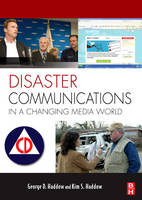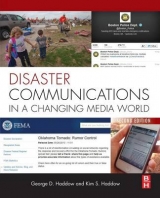
Disaster Communications in a Changing Media World
Butterworth-Heinemann Ltd (Verlag)
978-1-85617-554-8 (ISBN)
- Titel erscheint in neuer Auflage
- Artikel merken
Communications is key to the success of disaster mitigation, preparedness, response and recovery. Accurate information disseminated to the general public, to elected officials and community leaders, and to the media reduces risk, saves lives and property, and speeds recovery. The ability to communicate is no longer an afterthought or a luxury; timely communication is now as important as logistics or the pre-deployment of materials. Planning and controlling the flow of information before, during and after a disaster will define your organization's credibility, trustworthiness, authority, and effectiveness.The emergence of new media like the internet, e-mail, blogs, text messaging, cell phone photos, and the increasing role played by "first informers"-- witnesses who now have the ability to transmit information immediately from the event--are redefining the roles of government and media.The government's historical role as gatekeeper is now an anachronism. Traditional media's role as the sole conduit of reliable and officially-sanctioned information has been eclipsed by the advent of new media. The tools and rules of communications are evolving and disaster communications must evolve to capitalize on these changes and exploit the opportunities they provide. Bloggers have the potential either to add to the chaos during a crisis, or to help convey accurate data and report on local conditions. Disaster communications must incorporate a way to manage their impact and if possible use them for the common good.Finally, even though the means to the end are evolving, the goals, the values, and the underlying principles of effective disaster communication-- the need for transparency, increased accessibility, trustworthiness and reliability, and to create partnerships with the media--have not changed and need to be embraced along with the practical ability to convey information effectively.
George Haddow currently serves as Senior Fellow at the Disaster Resilience Leadership Academy (DRLA) at Tulane University in New Orleans, LA and previously served as an Adjunct Faculty and Research Scientist, Institute for Crisis, Disaster and Risk Management, George Washington University in Washington, DC. at Prior to joining academia, Mr. Haddow worked for eight years in the Office of the Director of the Federal Emergency Management Agency (FEMA) as the White House Liaison and the deputy Chief of Staff. He is a founding partner of Bullock & Haddow LLC, a disaster management consulting firm. Kim Haddow is the president of Haddow Communications in New Orleans – a company specializing in strategic media planning, messaging, and developing research-driven media content, branding and advertising materials for non-profits. Clients have included: the Rockefeller Family Fund, Sierra Club, Make It Right Foundation, U.S. State Department, Public Campaign, and the Trust for America’s Health. Haddow also worked for eight years at Greer, Margolis, Mitchell, Burns (GMMB), a Washington, DC- based media consulting firm, advising political campaigns and non-profits. Haddow began her career at WWL-AM in New Orleans where she managed the news department
Chapter One - Communications: The Critical FunctionEssential to success - best case examples where effective communications clearly contributed to the success of the operation - Northridge for response, Napa for mitigation; worst case examples where inadequate and inept communications planning and implementation costs lives, damaged response, or delayed recovery - Hurricane Katrina, the Loma Prieta earthquake.Chapter Two - Disaster communications in a changing media worldDefinition of new media, examples of use in disasters - Katrina, July 7 London bombing,Examples of changing role of traditional media and government --9/11Chapter Three - The Principles of a successful communications strategyBasic assumptions and examples of each:* Transparency* Accuracy* Accessibility* Customer focus* Leadership commitment* Communications core to planning* Partnership role with media* Need to create emotional connection with audience, be trusted - Rudy Giuliani on September 11, Chief Moose in the DC sniper incidentChapter Four - Application of principles to all four phases of disaster* Mitigation* Preparedness* Response* Recovery* The challenges of communicating riskChapter Five - Identification of audiences * Public* Elected officials and community leaders* Partners - public health, first responders, volunteers* MediaChapter Six - Creating infrastructure* Staffing* Tools and technologiesChapter Seven - Working with the media* How a newsroom works, staffing, deadlines, * Ho
| Erscheint lt. Verlag | 12.11.2008 |
|---|---|
| Verlagsort | Oxford |
| Sprache | englisch |
| Maße | 184 x 260 mm |
| Gewicht | 540 g |
| Themenwelt | Sozialwissenschaften ► Kommunikation / Medien ► Kommunikationswissenschaft |
| Sozialwissenschaften ► Soziologie | |
| Wirtschaft ► Betriebswirtschaft / Management ► Marketing / Vertrieb | |
| ISBN-10 | 1-85617-554-5 / 1856175545 |
| ISBN-13 | 978-1-85617-554-8 / 9781856175548 |
| Zustand | Neuware |
| Informationen gemäß Produktsicherheitsverordnung (GPSR) | |
| Haben Sie eine Frage zum Produkt? |
aus dem Bereich



